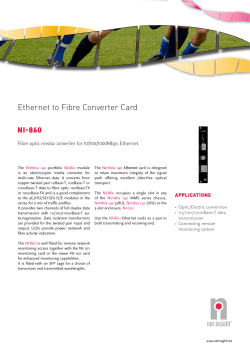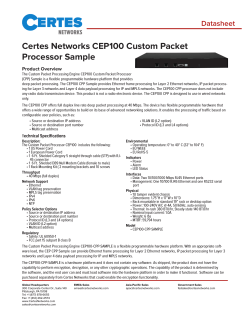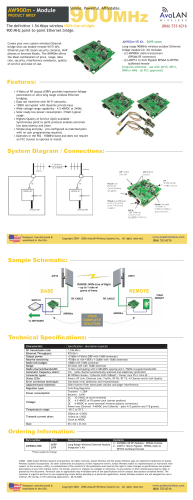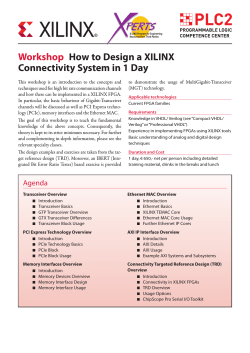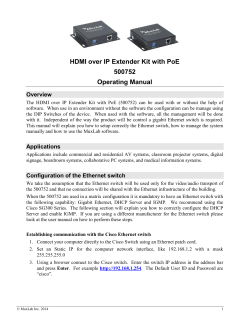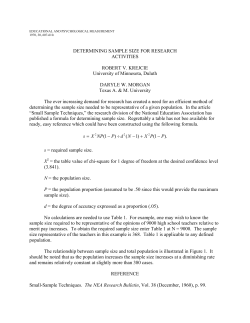
Integrated Packet Exchange Functionality for the SN 9000 Switching
DATASHEET Integrated Packet Exchange Functionality for the SN 9000 Maximum Flexibility for Seamless Evolution to Packet Switching EMPOWERING CARRIER-CLASS ETHERNET SERVICES The Coriant™ SN 9000 Integrated Packet Exchange (IPX) solution extends the packetoptimized service features of the Coriant™ SN 9000 Multiservice Switch with nodeand network-wide Ethernet switching capability. The IPX solution expands upon the rich diversity of packet services supported by Coriant’s next-generation multiservice switching platform by enhancing carrier-class Ethernet Private Line (EPL) and Ethernet Virtual Private Line (EVPL) services across a network-wide packet switching layer, conforming service delivery to Metro Ethernet Forum (MEF) Ethernet Services bandwidth profiles, and maintaining reliability with operations, administration, and maintenance (OAM) functionality expected by carrier networks. Building upon the SN 9000’s versatile architecture, the Packet Xchange Module (PXM) provides node-wide packet switching and is central to the establishment of an efficient and reliable network-wide packet layer. Through a packet-optimized Multiservice Card (MSC), carrier-class Ethernet services can be efficiently aggregated and switched both locally and network wide. Configurable flow rate descriptors (CIR, CBS, EIR and EBS), Virtual LAN (VLAN) tags, and Ethernet OAM reflect our commitment to standards-based interoperability and further enhance the SN 9000’s packet versatility and reliability. INCREASING OPERATIONAL SIMPLICITY The IPX solution offers a new realm of flexibility to Ethernet services. The 8-port MSC service interface module (SIM) occupies a single slot and can be placed in any of the SN 9000’s 32 universal card slots (non-PXM-located slots). The card uses small form-factor pluggable (SFP and SFP+) optics modules to support 100/1000 Mbps electrical and 100 Mbps/1 GigE/10GigE optical Ethernet interfaces, and each port can be provisioned for a different type of Ethernet service. Network operators select interfaces from a variety of pluggable modules to meet the specific requirements of each site, and can choose Ethernet pluggable optical modules (POMs) from among SFPs already available for Coriant’s SN 9000 and SFP+ POMs introduced with the IPX solution. The SFP+ POMs not only provide 10 GigE interfaces, but can alternatively provide OC-192/STM-64 support on the MSC. Every Ethernet service can be tailored to meet the needs of the end-customer with user-configurable bandwidth profiles. The IPX supports MEF Ethernet Services bandwidth profile definitions for Ethernet UNIs and specified traffic within a service with customer-defined Class of Service (CoS) identification. This information is utilized at the time the Ethernet service is created to help determine a route through the network for the provisioned connection that can accommodate the specific bandwidth demands of the connection, including: Committed Information Rate (CIR), Committed Burst Size (CBS), Excess Information Rate (EIR), and Excess Burst Size (EBS). BENEFITS OF THE CORIANT™ INTEGRATED PACKET EXCHANGE (IPX) ■■ Efficient Delivery of Carrier-Class Ethernet Services ■■ Network-Wide Ethernet Switching Layer ■■ Port- or Flow-based Switching and Aggregation of Ethernet Traffic ■■ Reduces Operational Costs and Complexity ■■ Simplifies the Transition from TDM to Packet-Based Services Multi-Rate Ethernet 1 GigE/10 GigE Network-Wide Ethernet Switching Layer Legacy TDM Legacy TDM Transport and Service Layer SN 9000 SONET/SDH OC-n/ STM-n 1 GigE/ 10 GigE DS1 DS3 100 Mbps Ethernet 1 GigE 10 GigE OC-n Transmuxed OC-n The Coriant Integrated Packet Exchange (IPX) solution extends the packet-optimized service features of the SN 9000 with node- and network-wide Ethernet switching capability, enabling service providers to more efficiently and cost-effectively deliver carrier-class Ethernet services while simultaneously supporting traditional TDM-based revenue traffic. LEVERAGING SERVICE REVENUES The IPX enables the extremely flexible architecture of the SN 9000 to support the migration from TDM to packet services in metro networks, simultaneously supporting both native SONET/SDH and Ethernet switching. Carriers can maintain their current TDM revenues while offering next-generation, high-reliability Ethernet services. As the end-customer demand for packet data increases, the SN 9000 can adapt without impacting any services transported by the node. Every optical link in the network has revenue potential. Packet-based services offer the benefit of statistical multiplexing which enables the carrier to place more revenue-generating services on each network link. With the IPX’s user-configurable bandwidth profiles, the network operator can be assured that they are optimizing their infrastructure while ensuring compliance with their Service Level Agreements (SLAs). CARRIER-CLASS RELIABILITY FEATURES End-customers have come to expect a high level of reliability from the services they receive from the carrier. Operating the packet layer at Layer 2 (Ethernet and MPLS) rather than at the IP service layer (Layer 3) provides more flexibility for carriers to offer a range of service types, with varying delivery guarantees, latency, and protection options. The IPX offers new features that enable carriers to offer such reliability. Standards-based link OAM helps the network operator to ensure that two directly-connected Ethernet peers maintain bidirectional communications and monitors the link quality to ensure that an acceptable level of performance is maintained. End-to-end connectivity OAM helps the network operator manage the health of circuits which span multiple interconnected Ethernet networks which may be managed as different administrative domains, allowing the operator to quickly detect and isolate connectivity issues, and verify performance against SLAs. Besides OAM, carrier-class reliability can be achieved via Layer 2 protection mechanisms focused at the Ethernet link as well as the end-toend MPLS-TP connection level. Link Aggregation (LAG) consistent with IEEE 802.1AX provides Ethernet link protection. MPLS-TP 1:1 Linear APS, consistent with ITU-T G.8131 and IETF RFC 6378, provides protection for end-to-end Layer 2 connections. Historically, Ethernet networks have not been synchronized, but with Ethernet now extending to new applications and services which require more accurate timing with the network (e.g., voice services), synchronization of the Ethernet network elements is critical. 2 Integrated Packet Exchange (IPX) To ensure that Ethernet-based services are properly synchronized, the MSC distributes a timing reference from the SN 9000’s system clock via Synchronous Ethernet (SyncE) messaging over the Ethernet interface, offering a timing reference similar to that which is currently available with SONET/SDH interfaces. The SN 9000 is also capable of deriving system timing from other Ethernet network nodes via the MSC’s Ethernet interface, enabling the SN 9000 to maintain reference to highly reliable timing sources as the network transitions from SONET/SDH interfaces to all Ethernet. SIMPLIFYING THE DELIVERY AND MANAGEMENT OF ETHERNET SERVICES The SN 9000 brings the advantages of Coriant network intelligence to switched Ethernet transport. Simplified end-to-end provisioning, flow control, and enhanced performance management features of Coriant™ SILVX® NMS provide easier customization and assured service delivery. Building on the trusted SILVX NMS foundation, network-wide packet switching can be easily managed and provisioned. Layer 2 service trunks represent transport connections between SN 9000 packet-capable nodes for carrying Layer 2 circuits. With the assistance of SILVX, the network operator provisions a packet-based services layer between packet-capable SN 9000 nodes. All Ethernet services can then be provisioned to MPLS-TP circuits across the network with point-and-click provisioning. Should a failure occur anywhere within the network, the network operator can readily identify the affected Layer 2 service trunks and circuits. And, with NMS-provisioned Ethernet OAM, the network operator can readily identify and isolate issues impacting the end-to-end Ethernet services. TECHNICAL SPECIFICATIONS 8x Multiservice Card (MSC) •8 ports per card •Port speed 100/1000 Mbps electrical and 100 Mbps/1 GigE/10 GigE optical •Traffic policing on Layer 2 flows - Portbased and flow-based •Configurable flow rate descriptors (CIR, CBS, EIR and EBS) for traffic management •Configurable frame sizes from 64 to 9600 bytes •Performance Monitoring (Current, 15 Min, 96 most recent 15 Min, 24 Hr Current and Previous Statistics) •Synchronous Ethernet (SyncE) •Ethernet link and end-to-end OAM •Equipment and facility port loopbacks •Single-width card •Usable in any of 32 multiservice slots (non-PXM-located slots) •Up to 29 cards or 232 ports per system •Power: 55 watts maximum per card Packet Exchange Module (PXM) •300 Gbps of Layer 2 service switching •Performs VLAN-based, Q-in-Q and MPLS-TP grooming •1+1 redundancy •Up to 2 cards per system •Power: 60 watts maximum per card Small Form-Factor Pluggables (SFP/ SFP+) •100BASE-FX SFP, 2 KM, MMF, 1310nm •100BASE-LX10 SFP: Long wavelength, 10 KM, SMF, 1310nm •100BASE-BX10-D SFP: 10 KM, Bi-directional, long wavelength downstream, 1550nm •100BASE-BX10-U SFP: 10 KM, Bidirectional, long wavelength upstream, 1310nm •10/100/1000BASE-T (10BaseT mode not supported) •1000BASE-SX SFP •1000BASE-LX SFP •1000BASE-ZX SFP •10GBASE-SR SFP+: 0.3 KM, 850nm •10GBASE-LR SFP+: 10 KM, 1310nm •10GBASE-ER SFP+: 40 KM, 1550nm •OC-192-SR STM-64.1-I OTU2/OTU2e 10GBASE-LR SFP+: 1310 nm •OC-192-IR-1 STM-64.1-S OTU2/OTU2e 10GBASE-ER SFP+: 1550nm •OC-192-LR-2 STM-64.2-L OTU2/OTU2e 10GBASE-ZR SFP+: 1550nm Optical Protection Switching Types •Linear, Ring, Mesh, Hybrid •1+1 Linear APS/MSP •UPSR/SNCP •1+1 Path Protected •Dynamic Source Reroute •Unprotected •Per port, software configurable Regulatory and Standards Compliance •IEEE 802.3 Ethernet •IEEE 802.3z Gigabit Ethernet •IEEE 802.1q VLAN Tag •IEEE 802.3ah Ethernet OAM (link) •ITU-T G.7041 Generic Framing Procedure •ITU-T G.8261 Packet Network Timing/ Synchronization •ITU-T Y.1731 Ethernet OAM (end-to-end) •MEF 6.1 / MEF 10.1 Ethernet UNI •IEEE 802.1AX Link Aggregation (LAG) •ITU-T G.8131 / IETF RFC 6378 1:1 MPLSTP Linear Protection Management Software •Node Management – SilvxSource® •Network Management – SilvxManager® These trademarks are owned by Coriant or its affiliates: Coriant™, Coriant Dynamic Optical Cloud™, and mTera™. Other trademarks are the property of their respective owners. Statements herein may contain projections regarding future products, features, or technology and resulting commercial or technical benefits, which may or may not occur. This publication does not constitute legal obligation to deliver any material, code, or functionality. This document does not modify or supplement any product specifications or warranties. Copyright © 2014 Coriant. All Rights Reserved. 74C.0053 Rev. A 08/14 www.coriant.com
© Copyright 2026
